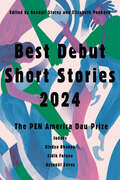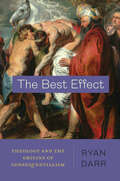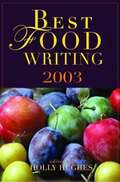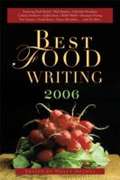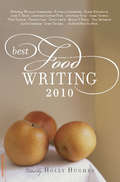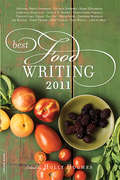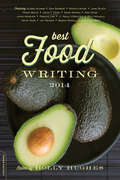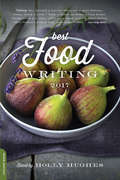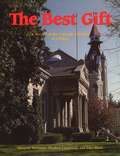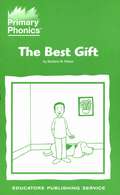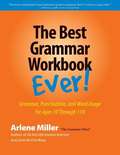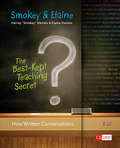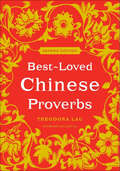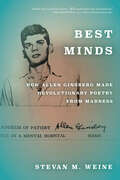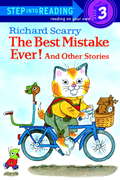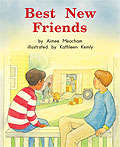- Table View
- List View
Best Debut Short Stories 2024: The PEN America Dau Prize
by Kendall Storey Elizabeth PankovaThe essential annual guide to the newest voices in literature, selected by Sindya Bhanoo, Ayşegül Savaş, and Sidik FofanaBest Debut Short Stories celebrates the most promising short story writers today. Selected by a panel of distinguished judges, these twelve stories are the 2024 winners of the PEN/Robert J. Dau Short Story Prize for Emerging Writers, which recognizes outstanding debuts published in literary magazines.
The Best Effect: Theology and the Origins of Consequentialism
by Ryan DarrA theological history of consequentialism and a fresh agenda for teleological ethics. Consequentialism—the notion that we can judge an action by its effects alone—has been among the most influential approaches to ethics and public policy in the Anglophone world for more than two centuries. In The Best Effect, Ryan Darr argues that consequentialist ethics is not as secular or as rational as it is often assumed to be. Instead, Darr describes the emergence of consequentialism in the seventeenth century as a theological and cosmological vision and traces its intellectual development and eventual secularization across several centuries. The Best Effect reveals how contemporary consequentialism continues to bear traces of its history and proposes in its place a more expansive vision for teleological ethics.
Best Food Writing 2003
by Holly D. HughesBest Food Writing 2003 assembles, for the fourth year, the most exceptional writing from the past year's books, magazines, newspapers, newsletters, and websites. Within its six sections--Stocking the Larder, Home Cooking, Someone's in the Kitchen, Dining Around, The Recipe File, and Personal Tastes--read our best writers on everything from celebrated chefs to extraordinary restaurants, from histories of vital ingredients to food-inspired memoirs. Included are pieces from such stars of the genre as John Thorne, Amanda Hesser, and Calvin Trillin. Selected as required reading by the Culinary Institute of America for all of its undergraduate students, neither cook nor food lover should be without this remarkable annual collection.
Best Food Writing 2006
by Holly D. Hughes"Best Food Writing 2006" assembles, for its seventh year, the most exceptional writing from the past year's books, magazines, newspapers, newsletters, and Web sites. Included are the best writers on everything from celebrated chefs to the travails of the home cook, from food sourcing at the greenmarket to equipping one's kitchen, from erudite culinary history to food-inspired memoirs. Like past collections, the 2006 round-up will include pieces from food-writing stars such as Robb Walsh, Ruth Reichl, Thomas McNamee, John Thorne, Calvin Trillin, Amanda Hesser, Colman Andrews, Jason Epstein, and Jeffrey Steingarten. Opinionated, evocative, nostalgic, brash, thought-provoking, and sometimes just plain funny, it's a tasty sampler to dip into time and again, whether you're in the mood for caviar -- or hot dogs.
Best Food Writing 2010
by Holly HughesA new edition of the authoritative and appealing anthology, comprised of the finest culinary prose from the past yearOCOs books, magazines, newspapers, newsletters, and Web sites. With food writing and blogging on the rise, thereOCOs no shortage of treats on the buffet to choose from, including selections from both established food writers and new stars on everything from noted gastronomes to how to fry an egg, from erudite culinary history to delectable memoirs. Evocative, provocative, sensuous, and just plain funny, itOCOs a tasty sampler platter to dip into time and again. "Best Food Writing 2010" features top-notch writers like Colman Andrews, Calvin Trillin, Ruth Reichl, Alice Waters, Frank Bruni, and many others. "
Best Food Writing 2011
by Holly D. HughesBest Food Writing 2011 authoritatively and appealingly assembles the finest culinary prose from the past year's books, magazines, newspapers, newsletters, and websites, featuring both established food writers, rising stars, and some literary surprises.
Best Food Writing 2014
by Holly HughesFor fourteen years, Best Food Writing has served up the creme de la creme of the year's food writing. The 2014 edition once again offers the tastiest prose of the year, from a range of voices: food writing stars, James Beard Award winners, writer-chefs, bestselling authors, and up-and-coming bloggers alike. With new sections devoted to "A Table for Everyone" and "Back to Basics," you'll find a topic and a flavor for every appetite--the cutting-edge, the thoughtful, the provocative, and the hilarious--a smorgasbord of treats for the foodie in all of us. Contributors include: Elissa Altman, Dan Barber, Monica Bhide, Sara Bir, John Birdsall, Jane Black, Frank Bruni, Albert Burneko, Tom Carson, Brent Cunningham, John T. Edge, Barry Estabrook, Amy Gentry, Adam Gopnik, Matt Goulding, John Gravois, Alex Halberstadt, Sarah Henry, Jack Hitt, Steve Hoffman, Ann Hood, Silas House, Rowan Jacobsen, John Kessler, Kate Krader, Francis Lam, David Leite, Irvin Lin, J. Kenji Lopez-Alt, Daniella Martin, Dave Mondy, Erin Byers Murray, Rick Nichols, Kim O'Donnel, Josh Ozersky, Kevin Pang, Ben Paynter, Michael Procopio, Jay Rayner, Besha Rodell, Anna Roth, Adam Sachs, Eli Saslow, David Sax, Oliver Strand, Laura Taxel, JT Torres, Molly Watson, Joe Yonan, Eagranie Yuh
Best Food Writing 2017
by Holly HughesFrom small-town bakeries to big city restaurants, Best Food Writing offers a bounty of everything in one place. For eighteen years, Holly Hughes has scoured both the online and print world to serve up the finest collection of food writing. This year, Best food Writing delves into the intersection of fine dining and food justice, culture and ownership, tradition and modernity; as well as profiles on some of the most fascinating people in the culinary world today. Once again, these standout essays--compelling, hilarious, poignant, illuminating--speak to the core of our hearts and fill our bellies. Whether you're a fan of Michel Richard or Guy Fieri--or both--there's something for everyone here. Take a seat and dig in.
Best Friends
by Tina AthaideBest Friends written by Tina Athaide, photographed by Maria Victoria Torrey.
The Best Gift: A Record of the Carnegie Libraries in Ontario
by Margaret Beckman Stephen Langmead John BlackThis book is a vivid reminder of the early days of library development in Ontario. The beautiful buildings which still grace Ontario towns and villages, as illustrated, are a part of our provincial heritage. By the turn of the century, a public library was perceived as an important element in the civic fabric of almost every Ontario community. However, the introduction of the Carnegie grants for library buildings gave impetus to the Ontario government programme for library development, and provided a focus for increased support of library services. Rivalry among neighbouring communities to secure a Carngie library heightened this awareness, as did the publicity – in some instances even controversy – which surrounded each step of the grant seeking, site selection and plan approval process. As well, the hitherto unexplored story of Carnegie grant process in each community has been examined, and the role of one man, James Bertram, secretary to Andrew Carnegie, is revealed in absorbing detail. Library plans and design elements are also discussed, and the influence of a few architects on the building designs is revealed; the fascinating involvement of Frank Lloyd Wright in the Pembroke Carnegie library building is one such example.
The Best Grammar Workbook Ever! Grammar, Punctuation and Word Usage for Ages 10 Through 110
by Arlene MillerIt covers grammar basics, common grammar problems, punctuation, capitalization, and word usage. In addition to a Pretest and Final Test, there are more than 100 practice exercises and tests at the end of each chapter. A complete list of answers is included in one of the appendixes. Other appendixes include commonly misspelled words, commonly mispronounced words, Greek and Latin word roots, and writing tips. The book is written in a friendly and easy-to-use tone. There are helpful hints throughout and a complete index.
The Best-Kept Teaching Secret: How Written Conversations Engage Kids, Activate Learning, Grow Fluent Writers . . . K-12 (Corwin Literacy)
by Elaine Daniels Smokey DanielsYour fast-track to student engagement Everywhere Smokey Daniels goes—every school he visits, every workshop he leads, every keynote he gives—there’s one teaching strategy that teachers embrace above all others. That single method for transforming students from passive spectators into active learners . . . for evoking curiosity, inspiring critical thinking, and building powerful writers along the way. Now, with Elaine Daniels as Smokey’s coauthor, that best-kept teaching secret is revealed to teachers at large: Written Conversations. Just what make Written Conversations so potent? An ongoing, thoughtful correspondence between students, and between students and their teachers, Written Conversations, above all else, catch and ride the wave of social interaction, which in turn makes school matter to kids. It’s that simple. Structure by structure, from beginning to end, Smokey and Elaine describe four variations of these "silent writing-to-learn discussions," during which all students in a classroom think and "talk" at once in writing, instead of one at a time out loud. How Written Conversations Work It all starts with mini-memos, short student letters that teachers use to introduce, extend, and assess class work. Then come dialogue journals, where pairs dive deeply into academic subjects. Next, groups of three or four students join in extended written discussions called write-arounds. Finally, kids take their thinking online, where they enjoy digital discussions with partners from their own classroom—and with kids from around the world. . . . all the while, you are supported by detailed descriptions of each structure, lessons, and annotated student samples—making this the most practical teaching book in recent memory. What kid wouldn’t want to refine written argument skills, clarify a point, or defend another’s viewpoint, when the "audience" is people who matter? And Yes, Written Conversations align with the Common Core Standards for writing, reading, language, and speaking and listening, taking students well beyond the standards themselves.
The Best-Kept Teaching Secret: How Written Conversations Engage Kids, Activate Learning, Grow Fluent Writers . . . K-12 (Corwin Literacy)
by Elaine Daniels Smokey DanielsYour fast-track to student engagement Everywhere Smokey Daniels goes—every school he visits, every workshop he leads, every keynote he gives—there’s one teaching strategy that teachers embrace above all others. That single method for transforming students from passive spectators into active learners . . . for evoking curiosity, inspiring critical thinking, and building powerful writers along the way. Now, with Elaine Daniels as Smokey’s coauthor, that best-kept teaching secret is revealed to teachers at large: Written Conversations. Just what make Written Conversations so potent? An ongoing, thoughtful correspondence between students, and between students and their teachers, Written Conversations, above all else, catch and ride the wave of social interaction, which in turn makes school matter to kids. It’s that simple. Structure by structure, from beginning to end, Smokey and Elaine describe four variations of these "silent writing-to-learn discussions," during which all students in a classroom think and "talk" at once in writing, instead of one at a time out loud. How Written Conversations Work It all starts with mini-memos, short student letters that teachers use to introduce, extend, and assess class work. Then come dialogue journals, where pairs dive deeply into academic subjects. Next, groups of three or four students join in extended written discussions called write-arounds. Finally, kids take their thinking online, where they enjoy digital discussions with partners from their own classroom—and with kids from around the world. . . . all the while, you are supported by detailed descriptions of each structure, lessons, and annotated student samples—making this the most practical teaching book in recent memory. What kid wouldn’t want to refine written argument skills, clarify a point, or defend another’s viewpoint, when the "audience" is people who matter? And Yes, Written Conversations align with the Common Core Standards for writing, reading, language, and speaking and listening, taking students well beyond the standards themselves.
Best-Loved Chinese Proverbs
by Theodora Lau Kenneth Lau Laura Lau"By filling one's head instead of one's pocket, one cannot be robbed."The appeal of Chinese proverbs is profound and universal. With brevity, clarity, and simplicity, these carefully chosen words help pass wisdom and insight throughout the ages. This timeless, eloquent collection of proverbs offers fundamental truths about the natural world and the human condition, on subjects such as:Ability • Adversity • Beauty • Character • Conflict Cooperation • Deception • Defeat • Fortune • Greed • Happiness Honor • Inspiration • Knowledge • Leadership • Love Moderation • Necessity • Neighbors • Obstinacy • Opportunity Perseverance • Pride • Sincerity • Strategy • Success Thought • Trust • Victory • Wisdom • And More"With our thoughts we must build our world."
Best Minds: How Allen Ginsberg Made Revolutionary Poetry from Madness
by Stevan M. WeineWINNER, 2024 BEAT STUDIES ASSOCIATION AWARDSA revelatory look at how poet Allen Ginsberg transformed experiences of mental illness and madness into some of the most powerful and widely read poems of the twentieth century.Allen Ginsberg’s 1956 poem “Howl” opens with one of the most resonant phrases in modern poetry: “I saw the best minds of my generation destroyed by madness.” Thirty years later, Ginsberg entrusted a Columbia University medical student with materials not shared with anyone else, including psychiatric records that documented how he and his mother, Naomi Ginsberg, struggled with mental illness.In Best Minds, psychiatrist, researcher, and scholar Stevan M. Weine, M.D., who was that medical student, examines how Allen Ginsberg took his visions and psychiatric hospitalization, his mother’s devastating illness, confinement, and lobotomy, and the social upheavals of the postwar world and imaginatively transformed them.Though madness is often linked with hardship and suffering, Ginsberg’s showed how it could also lead to profound and redemptive aesthetic, spiritual, and social changes. Through his revolutionary poetry and social advocacy, Ginsberg dedicated himself to leading others toward new ways of being human and easing pain. Throughout his celebrated career Ginsberg made us feel as though we knew everything there was to know about him. However, much has been left out about his experiences growing up with a mentally ill mother, his visions, and his psychiatric hospitalization.In Best Minds, with a forty-year career studying and addressing trauma, Weine provides a groundbreaking exploration of the poet and his creative process especially in relation to madness.Best Minds examines the complex relationships between mental illness, psychiatry, trauma, poetry, and prophecy—using the access Ginsberg generously shared to offer new, lively, and indispensable insights into an American icon. Weine also provides new understandings of the paternalism, treatment failures, ethical lapses, and limitations of American psychiatry in the 1940s and 1950s.In light of these new discoveries, the challenges Ginsberg faced appear starker and his achievements, both as a poet and an advocate, even more remarkable.
The Best Mistake Ever! and Other Stories (Step into Reading)
by Richard ScarryNow available as an eBook! Richard Scarry presents three humorous tales about happily resolved misunderstandings in the busy world of Lowly Worm and Huckle Cat.
Best New Friends (Fountas & Pinnell LLI Green #Level G, Lesson 96)
by Aimee MeachamFountas and Pinnell Leveled Literacy Intervention Green System -- 1st Grade
Best Newspaper Writing 1981
by Roy P. ClarkBest Newspaper Writing 1981 celebrates the winners of the ASNE's Distinguished Writing Awards, including the Jesse Laventhol Awards, created to honor deadline reporting. It includes interviews with the winners about their craft; the work of 17 other writers who share the lessons they learned; study questions useful to students, teachers, and working journalists; a bibliography; and essays to help readers improve their writing.
Best Newspaper Writing 1982
by Roy P. ClarkBest Newspaper Writing 1982 celebrates the winners of the ASNE's Distinguished Writing Awards, including the Jesse Laventhol Awards, created to honor deadline reporting. It includes interviews with the winners about their craft; the work of 17 other writers who share the lessons they learned; study questions useful to students, teachers, and working journalists; a bibliography; and essays to help readers improve their writing.
Best Newspaper Writing 1983
by Roy P. ClarkBest Newspaper Writing 1983 celebrates the winners of the ASNE's Distinguished Writing Awards, including the Jesse Laventhol Awards, created to honor deadline reporting. It includes interviews with the winners about their craft; the work of 17 other writers who share the lessons they learned; study questions useful to students, teachers, and working journalists; a bibliography; and essays to help readers improve their writing.
Best Newspaper Writing 1984
by Roy Peter ClarkThis is the most useful and up-to-date anthology available for feature writing and introduction to journalism classes. This emphasizes the local reporting, news stories and pedagogical tools to become better writers.
Best Newspaper Writing 1987
by Don FryThe Poynter Institute for Media Studies proudly publishes the ninth volume of its series Best Newspaper Writing, valued since 1979 by students, teachers, and professionals as an indispensable text on clear, effective, and graceful newswriting.
Best Newspaper Writing 1989
by Don FryBest Newspaper Writing 1989 award categories include deadline writing, non-deadline writing, commentary, editorial writing, and state and local government reporting.
